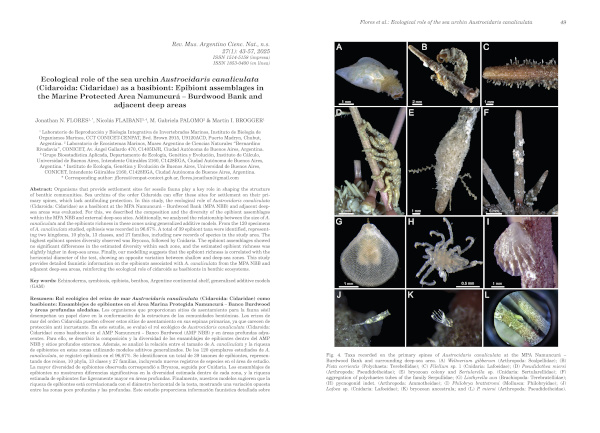Ecological role of the sea urchin Austrocidaris canaliculata (Cidaroida: Cidaridae) as a basibiont: Epibiont assemblages in the Marine Protected Area Namuncurá – Burdwood Bank and adjacent deep areas
Palabras clave:
Equinodermos, simbiosis, epibiota, bentos, plataforma continental Argentina, modelos aditivos generalizados (GAM)Resumen
Organisms that provide settlement sites for sessile fauna play a key role in shaping the structure of benthic communities. Sea urchins of the order Cidaroida can offer these sites for settlement on their primary spines, which lack antifouling protection. In this study, the ecological role of Austrocidaris canaliculata (Cidaroida: Cidaridae) as a basibiont at the MPA Namuncurá – Burdwood Bank (MPA NBB) and adjacent deep-sea areas was evaluated. For this, we described the composition and the diversity of the epibiont assemblages within the MPA NBB and external deep-sea sites. Additionally, we analyzed the relationship between the size of A. canaliculata and the epibionts richness in these zones using generalized additive models. From the 120 specimens of A. canaliculata studied, epibiosis was recorded in 96.67%. A total of 39 epibiont taxa were identified, representing two kingdoms, 10 phyla, 13 classes, and 27 families, including new records of species in the study area. The highest epibiont species diversity observed was Bryozoa, followed by Cnidaria. The epibiont assemblages showed no significant differences in the estimated diversity within each zone, and the estimated epibiont richness was slightly higher in deep-sea areas. Finally, our modelling suggests that the epibiont richness is correlated with the horizontal diameter of the test, showing an opposite variation between shallow and deep-sea zones. This study provides detailed faunistic information on the epibionts associated with A. canaliculata from the MPA NBB and adjacent deep-sea areas, reinforcing the ecological role of cidaroids as basibionts in benthic ecosystems.
Descargas

Descargas
Publicado
Número
Sección
Licencia
Los autores/as que publiquen en esta revista aceptan las siguientes condiciones:- Los autores/as conservan los derechos de autor y ceden a la revista el derecho de la primera publicación, con el trabajo registrado con la licencia de atribución de Creative Commons, que permite a terceros utilizar lo publicado siempre que mencionen la autoría del trabajo y a la primera publicación en esta revista.
- Se permite y recomienda a los autores/as a publicar su trabajo en Internet (por ejemplo en páginas institucionales o personales), ya que puede conducir a a una mayor y más rápida difusión del trabajo publicado.
